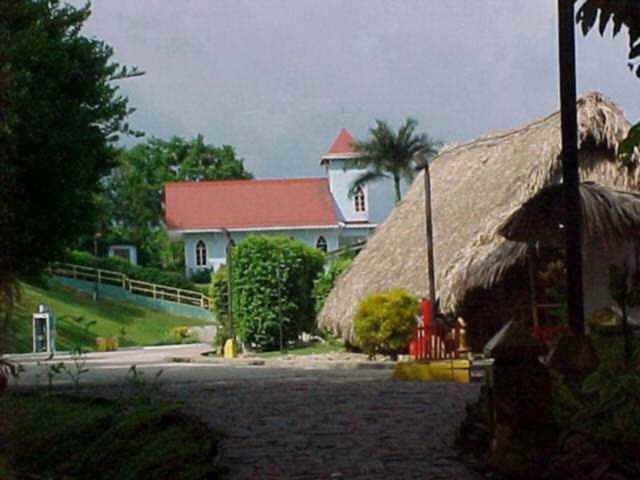
Indian Village - Kuna
hut in foreground
[Photo by WHO Aug 2002]
TRANSFORMATION
COMING FOR MI PUEBLITO?
In mid-November 2004,
Panamanian media reported that Panamanian Minister of Tourism Ruben Blades
and Panama City Mayor Juan Carlos Navarro are considering establishing a
school of tourism and hotel operations at Mi Pueblito. Such was
discussed with the president of the School of Hotel Operations and Tourism
of Valencia, Spain, during his visit to Panama. They believe the facilities of Mi Pueblito, which
are now considered underutilized, could accommodate such a school for
300-500 students. (As of January 2006, nothing more reported on this
subject.)
The topic of Mi
Pueblito in financial straits arose again in May 2005 with El
Panamá América (May 18, 2005) reporting that the tourist
complex is losing considerable money. According to recent
information from the Mayor's Office (as reported by El Panamá
América), in addition to the initial costs of slightly more
than $3 million to establish the complex (land donated by the Intervocalic
Region Authority-ARI and construction costs of the three villages)
maintenance expenses total $250,000 annually which are offset by
only some $24,000 generated from visitors entry fees, thus leaving
an annual deficit of $226,000. Also reported was planned
$30,000 worth of renovation projects of parts of the tourist
complex. Some consider the popularity of the facilities at Amador
and on the islands of Flamenco and Naos to be a factor in the
underutilization of Mi Pueblito by tourists.
Perhaps if routinely
offered attractions and events (such as the annual Panamanian dances
with the typical polleras attire held during the dry season
up to the recent past at the ruins of Panama Viejo during the dry
season) were scheduled at the center and aggressively promoted -- as
well as other promotion techniques aimed at drawing more tourist
interest might promote greater tourist interest and revenues. Former
Panama City Mayor Mayin Correa, originator and promoter of the
tourist center, was quoted in the article as saying the project was
never conceived as a business.
It is not known whether such
the school mentioned earlier would replace Mi Pueblito as a tourist attraction or
complement it. [If this excellent tourist site should be closed to
tourists that would deprive tourists a close-in opportunity for seeing and
appreciating Panamanian
culture, especially at a time when Panama is aggressively promoting
tourism. In no way do the various activities at Amador and the nearby
islands compete with Mi Pueblito considering themes. They are
complementary. -- WHO]
WHO's NOTES
Mi
Pueblito
is open from Tuesday - Sunday from 9:00 a.m.- 9:00 p.m.; closed on
Mondays. It costs $1.00 to visit all three villages (50 cents for
retirees).
Principal sources used
for this section:
Interoceanic Region
Authority (ARI), email communications and its website, and Panamanian
newspapers.
<<preceding
page
NEXT
PAGE>>
Site
designed, developed, and owned by
William
H. Ormsbee, Jr. 2005
![]() SCROLL
SCROLL